26. Creating KVM Virtual Machines using Cockpit and virt-manager
KVM-based virtual machines can easily be configured on Ubuntu using either the virt-install command-line tool, the virt-manager GUI tool or the Virtual Machines module of the Cockpit web console. For the purposes of this chapter we will use Cockpit and the virt-manager tool to install a Fedora distribution as a KVM guest on an Ubuntu host.
The command-line approach to virtual machine creation will be covered in the next chapter entitled “Creating KVM Virtual Machines with virt-install and virsh”.
26.1 Installing the Cockpit Virtual Machines Module
By default, the virtual machines module may not be included in a standard Cockpit installation. Assuming that Cockpit is installed and configured, the virtual machines module may be installed as follows:
# apt install cockpit-machines
Once installed, the Virtual Machines option (marked A in Figure 26-1) will appear in the navigation panel next time you log into the Cockpit interface:

26.2 Creating a Virtual Machine in Cockpit
To create a virtual machine in Cockpit, simply click on the Create VM button marked B in Figure 26-1 to display the creation dialog.
Within the dialog, enter a name for the machine and choose whether the installation media is in the form of an ISO accessible via a URL or a local filesystem path. Ideally, also select the vendor and operating system type information for the guest. While not essential, this will aid the system in optimizing the virtual machine for the guest.
Also specify the size of the virtual disk drive to be used for the operating system installation and the amount of memory to be allocated to the virtual machine:
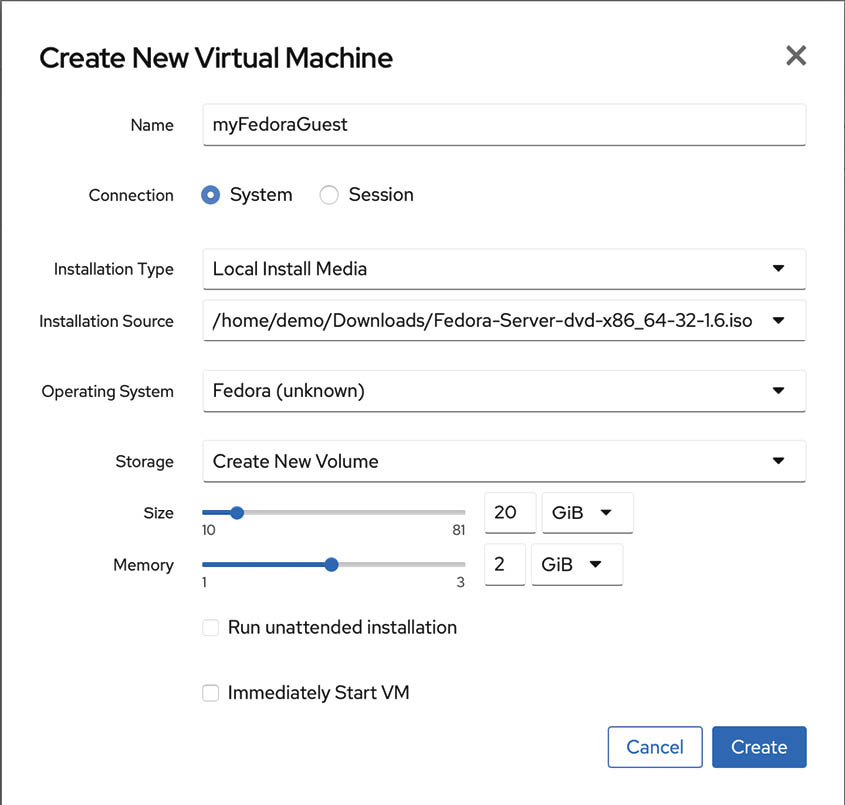
Note that Cockpit provides the choice of running the guest with a Session or System connection. If the system option is selected, the guest will connect to the system instance of the libvirtd service which is already running in the background with root privileges. The session option, however, starts a new libvirtd service that is owned by the current user and then connects the host to it. A session guest will, by default, use a storage pool that is local to the user’s account (for example /home/demo/.local/share/libvirt/images) and will be accessible only to the owner. A system session, on the other hand will be accessible to all users with appropriate privileges and will, by default, use storage located in /var/lib/libvirt/images.
For this example, select the System option, leave the Immediately Start VM option unselected and, once the new virtual machine has been configured, click on the Create button to build the virtual machine. After the creation process is complete, the new VM will appear in Cockpit as shown in Figure 26-3:

As described in “An Overview of Virtualization Techniques”, KVM provides virtual machines with a number of options in terms of network configuration. To view and change the network settings of a virtual machine, click on the Network interfaces tab as shown in Figure 26-4 followed by the Edit button located next to the network entry:

In the resulting dialog, the Network Type menu may be used to change the type of network connection, for example from virtual network (NAT) to direct (MacVTap).
26.3 Starting the Installation
To start the new virtual machine and begin installing the guest operating system from the designated installation media, click on the Install button highlighted in Figure 26-3 above. Cockpit will start the virtual machine and switch to the Consoles view where the guest OS screen will appear:

Figure 26-5
If the installation fails, check the message to see if it reads as follows:
unsupported configuration: CPU mode ‘custom’ for x86_64 kvm domain on x86_64 host is not supported by hypervisor
To resolve this issue, delete the newly created virtual machine, reboot the system and then recreate the machine.
Alternatively, check whether the message reads as follows:
Could not open ‘<path to iso image>’: Permission denied
Domain installation does not appear to have been successful.
This usually occurs because the QEMU emulator runs as a user named qemu which does not have access to the directory in which the ISO installation image is located. To resolve this issue, open a terminal window (or connect with SSH if the system is remote), change directory to the location of the ISO image file and add the qemu user to the access control list (ACL) of the parent directory as follows:
# cd /path/to/iso/directory
# setfacl --modify u:qemu:x ..
After making this change, check the setting as follows:
# getfacl ..
# file: ..
# owner: demo
# group: demo
user::rwx
user:qemu:--x
group::---
mask::--x
other::---
Once these changes have been made, click on the Install button once again to complete the installation.
To complete the installation, interact with the screen in the Consoles view just as you would if you were installing the operating system on physical hardware.
It is also possible to connect with and display the graphical console for the VM from outside the Cockpit browser session using the virt-viewer tool. To install virt-viewer on an Ubuntu system, run the following command:
# apt install virt-viewer
The virt-viewer tool is also available for Windows systems and can be downloaded from the following URL:
https://virt-manager.org/download/
To connect with a virtual machine running on the local host, simply run virt-viewer and select the virtual machine to which you wish to connect from the resulting dialog:

Figure 26-6
The above command will list system-based virtual machines. To list and access session-based guests, launch virt-viewer as follows:
$ virt-viewer --connect qemu:///session
Alternatively, it is also possible to specify the virtual machine name and bypass the selection dialog entirely, for example:
$ virt-viewer myFedoraGuest
$ virt-viewer --connect qemu:///session myFedoraGuest
To connect a virt-viewer instance to a virtual machine running on a remote host using SSH, the following command can be used:
$ virt-viewer --connect qemu+ssh://<user>@<host>/system <guest name>
For example:
$ virt-viewer --connect qemu+ssh://[email protected]/system MyFedoraGuest
When using this technique it is important to note that you will be prompted twice for the user password before the connection will be fully established.
Once the virtual machine has been created, the Cockpit interface can be used to monitor the machine and perform tasks such as rebooting, shutting down or deleting the guest system. An option is also included on the Disks panel to add additional disks to the virtual machine configuration.
26.4 Working with Storage Volumes and Storage Pools
When a virtual machine is created it will usually have associated with it at least one virtual disk drive. The images that represent these virtual disk drives are stored in storage pools. A storage pool can take the form of an existing directory on a local filesystem, a filesystem partition, physical disk device, Logical Volume Management (LVM) volume group or even a remote network file system (NFS).
Each storage pool is divided into one or more storage volumes. Storage volumes are typically individual image files, each representing a single virtual disk drive, but can also take the form of physical disk partitions, entire disk drives or LVM volume groups.
When a virtual machine was created using the previous steps, a default storage pool was created into which virtual machine images may be stored. This default storage pool occupies space on the root filesystem and can be reviewed from within the Cockpit Virtual Machine interface by selecting the Storage Pools option at the top of the panel marked C in Figure 26-1 above.
When selected, the screen shown in Figure 26-7 below will appear containing a list of storage pools currently configured on the system:
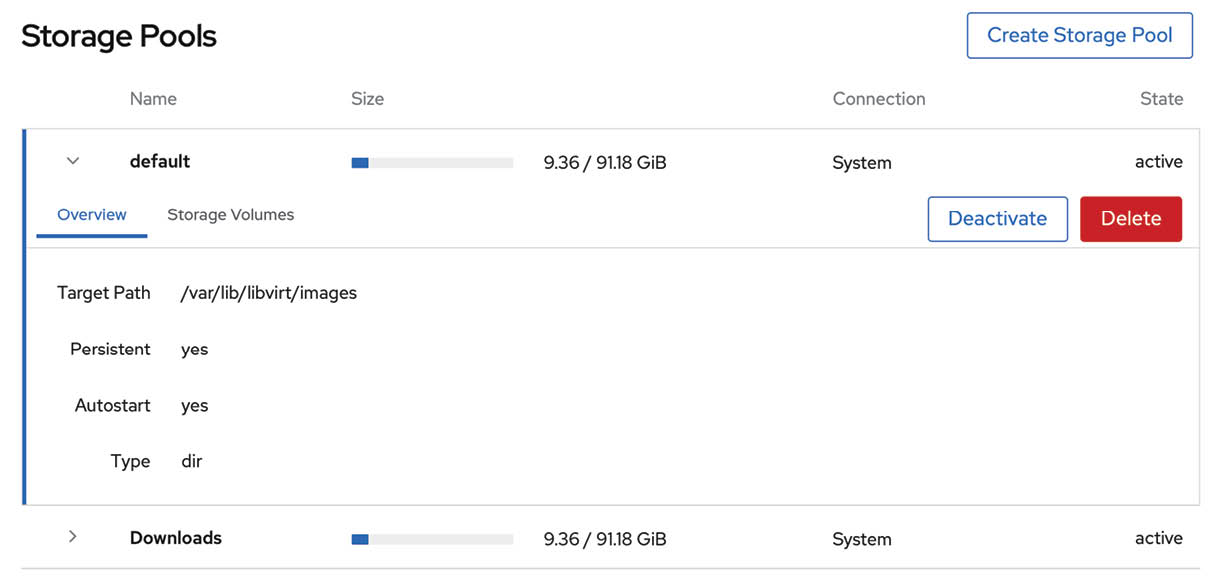
In the above example, the default storage pool is located on the root filesystem and stores the virtual machine image in the /var/lib/libvirtd/images directory. To view the storage volumes contained within the pool, select the Storage Volumes tab highlighted in Figure 26-8:

In the case of the Fedora guest, the storage volume takes the form of an image file named myFedoraGuest.qcow2. To find out which storage volume a particular virtual machine uses, return to the main Virtual Machine Cockpit screen, select the virtual machine and display the Disks panel as shown in Figure 26-9:
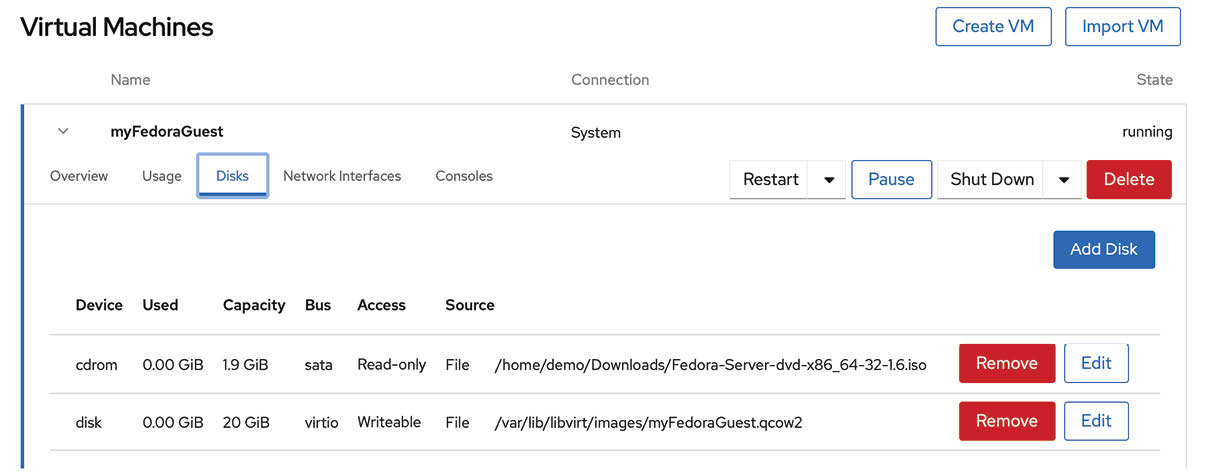
Although using the default storage pool is acceptable for testing purposes and early experimentation, it is recommended that additional pools be created for general virtualization use. To create a new storage pool, display the Storage Pools screen within Cockpit and click on the Create New Storage Pool button to display the dialog shown in Figure 26-10:

In the above example, a new storage pool is being created named MyPool using a file system partition mounted as /MyPool within the local filesystem (the topic of disk drives, partitions and mount points is covered later in the chapter entitled “Adding a New Disk Drive to an Ubuntu System”). Once created, the pool will now be listed within the Cockpit storage pool screen and can be used to contain storage volumes as new virtual machines are created.
At the time of writing, it was not possible to create a new storage volume within a custom storage pool from within the Cockpit interface. It is, however, possible to do this from within the Virtual Machine manager as outlined in the following section.
26.5 Creating a Virtual Machine using virt-manager
With the caveat that virt-manager may one day be discontinued once the Virtual Machines Cockpit extension is fully implemented, the remainder of this chapter will explore the use of this tool to create new virtual machines.
26.6 Starting the Virtual Machine Manager
Begin by launching Virtual Machine Manager from the command-line in a terminal window by running virt-manager. Once loaded, the virtual machine manager will prompt for the password of the currently active user prior to displaying the following screen:

Figure 26-11
The main screen lists the current virtual machines running on the system. By default the manager should be connected to the system libvirtd instance. If it is not, connect to the host system by right-clicking on the entry in the list and selecting Connect from the popup menu. To manage session-based virtual machines, select the File -> Add Connection... menu option to display the dialog shown in Figure 26-12:

Within this dialog, select QEMU/KVM user session from the Hypervisor menu and click on the Connect button. On returning to the main virt-manager screen, the user session hypervisor should now be listed:
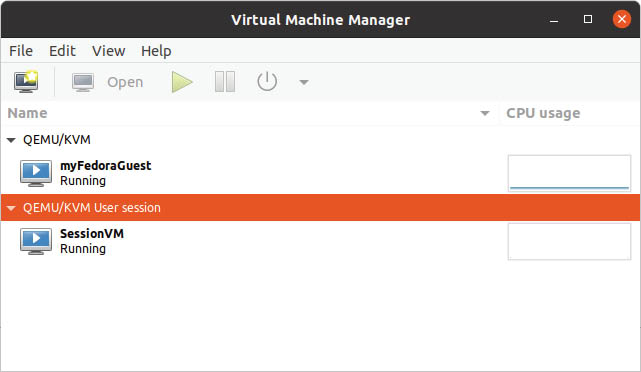
Figure 26-13
To create a new virtual system, click on the new virtual machine button (the far left button on the toolbar) or right-click on the hypervisor entry and select New from the resulting menu to display the first screen of the New VM wizard. In the Name field enter a suitably descriptive name for the virtual system. On this screen, also select the location of the media from which the guest operating system will be installed. This can either be a CD or DVD drive, an ISO image file accessible to the local host, a network install using HTTP, FTP, NFS or PXE or the disk image from an existing virtual machine:

Figure 26-14
26.7 Configuring the KVM Virtual System
Clicking Forward will display a screen seeking additional information about the installation process. The screen displayed and information required will depend on selections made in the preceding screen. For example, if a CD, DVD or ISO was selected, this screen will ask for the specific location of the ISO file or physical media device. This screen also attempts to identify the type and version of the guest operating system to be installed (for example the Windows version or Linux distribution) based on the installation media specified. If it is unable to do so, uncheck the Automatically detect from installation media / source option, type in the first few characters of the operating system name and select an option from the list of possible matches:

Figure 26-15
Once these settings are complete, click the Forward button to configure CPU and memory settings. The optimal settings will depend on the number of CPUs and amount of physical memory present in the host together with the requirements of other applications and virtual machines that will run in parallel with the new virtual machine:
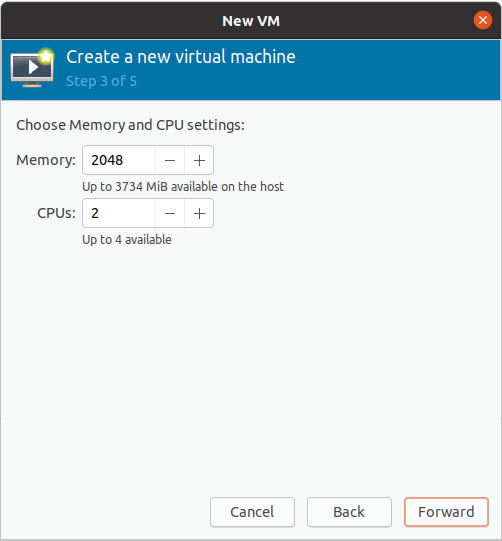
Figure 26-16
On the next screen, options are available to create an image disk of a specified size, select a pre-existing volume or to create a storage volume of a specified format (raw, vmdk, ISO etc). Unless you have a specific need to use a particular format (for example you might need to use vmdk to migrate to a VMware based virtualization environment at a later date) or need to use a dedicated disk or partition, it is generally adequate to simply specify a size on this screen:

Figure 26-17
If the default settings are used here, the virtual machine will use a storage volume within the default storage pool for the virtual disk drive. To make use of the custom “MyPool” storage pool created earlier in the chapter, enable the Select or create custom storage option before clicking on the Manage... button.
In the storage volume dialog, select the MyPool entry in the left hand panel, followed by the + button in the main panel to create a new storage volume:
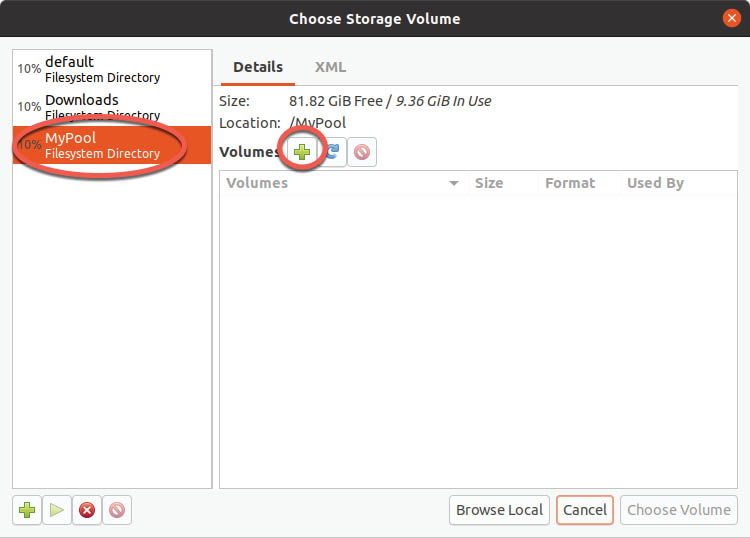
Figure 26-18
Note that the + button located in the bottom left-hand corner of the dialog may also be used to create new storage pools as an alternative to using the Cockpit interface.
In the configuration screen (Figure 26-19), name the storage volume, select the volume size and click on the Finish button to create the volume and assign it to the virtual machine:
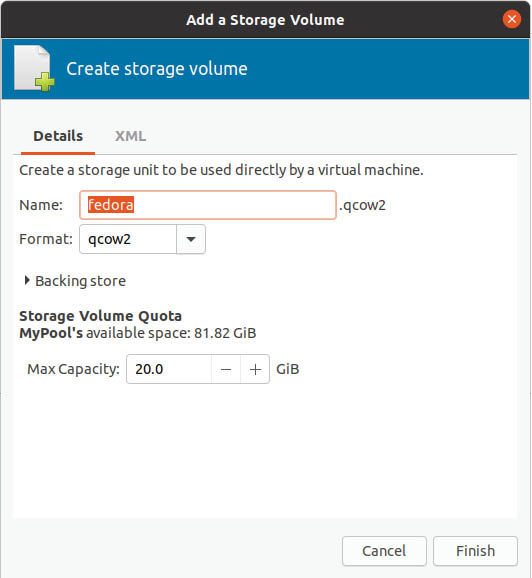
Once these settings are configured, select the new volume and click on the Choose Volume button. Click the Forward button once more. The final screen displays a summary of the configuration. Review the information displayed. Advanced options are also available to change the virtual network configuration for the guest as shown in Figure 26-20:

26.8 Starting the KVM Virtual Machine
Click on the Finish button to begin the creation process. The virtualization manager will create the disk and configure the virtual machine before starting the guest system. The new virtual machine will appear in the main virt-manager window with the status set to Running as illustrated in Figure 26-21:

By default, the console for the virtual machine should appear in the virtual machine viewer window. To view the console of the running machine at any future time, ensure that it is selected in the virtual machine list and select the Open button from the toolbar. The virtual machine viewer should be ready for the installation process to begin:
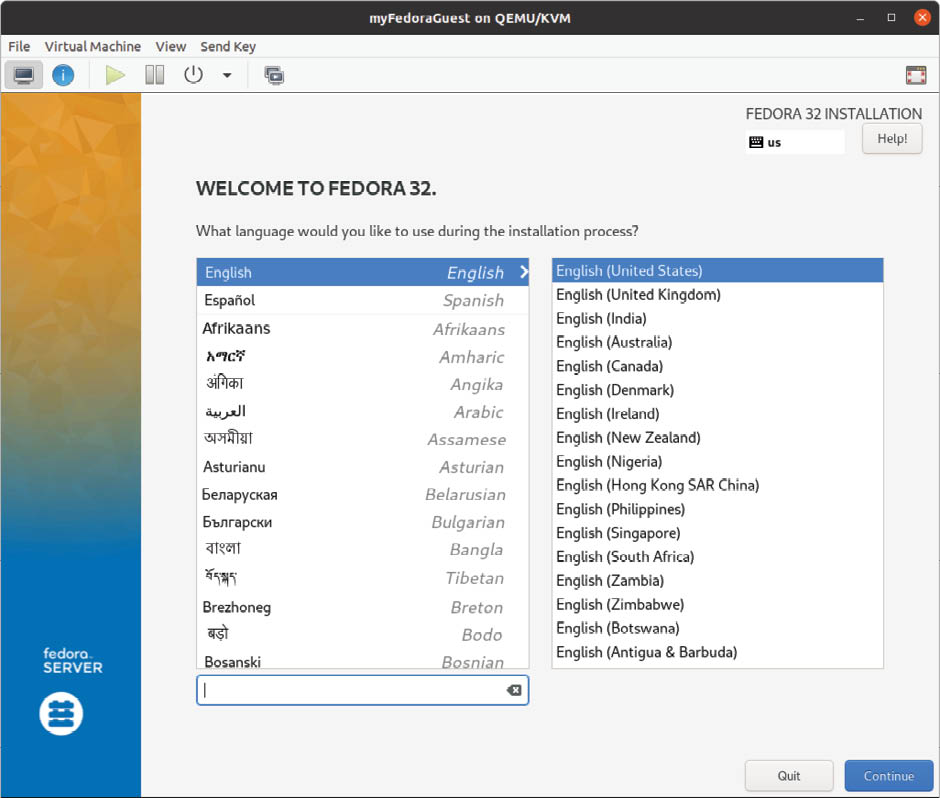
Figure 26-22
From this point on, simply follow the operating system installation instructions to install the guest OS in the KVM virtual machine.
This chapter has outlined two different ways to create new KVM-based virtual machines on an Ubuntu host system. The first option covered involves the use of the Cockpit web-based interface to create and manage virtual machines. This has the advantage of not requiring access to a desktop environment running on the host system. An alternative option is to use the virt-manager graphical tool. With these basics covered, the next chapter will cover the creation of virtual machines from the command-line.
